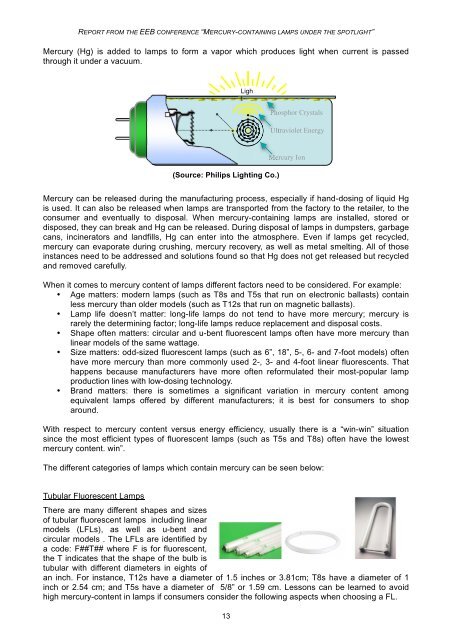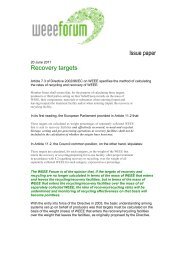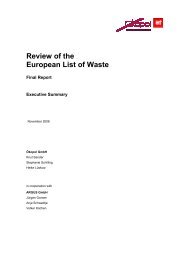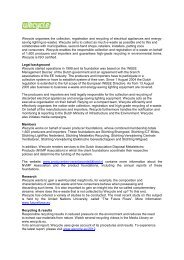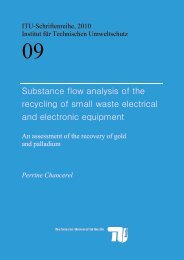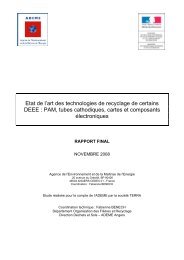Mercury containing lamps under the spotlight - WEEE Forum
Mercury containing lamps under the spotlight - WEEE Forum
Mercury containing lamps under the spotlight - WEEE Forum
You also want an ePaper? Increase the reach of your titles
YUMPU automatically turns print PDFs into web optimized ePapers that Google loves.
REPORT FROM THE EEB CONFERENCE “MERCURY-CONTAINING LAMPS UNDER THE SPOTLIGHT”<br />
<strong>Mercury</strong> (Hg) is added to <strong>lamps</strong> to form a vapor which produces light when current is passed<br />
through it <strong>under</strong> a vacuum.<br />
Ligh<br />
t<br />
Phosphor Crystals<br />
Ultraviolet Energy<br />
(Source: Philips Lighting Co.)<br />
<strong>Mercury</strong> Ion<br />
<strong>Mercury</strong> can be released during <strong>the</strong> manufacturing process, especially if hand-dosing of liquid Hg<br />
is used. It can also be released when <strong>lamps</strong> are transported from <strong>the</strong> factory to <strong>the</strong> retailer, to <strong>the</strong><br />
consumer and eventually to disposal. When mercury-<strong>containing</strong> <strong>lamps</strong> are installed, stored or<br />
disposed, <strong>the</strong>y can break and Hg can be released. During disposal of <strong>lamps</strong> in dumpsters, garbage<br />
cans, incinerators and landfills, Hg can enter into <strong>the</strong> atmosphere. Even if <strong>lamps</strong> get recycled,<br />
mercury can evaporate during crushing, mercury recovery, as well as metal smelting. All of those<br />
instances need to be addressed and solutions found so that Hg does not get released but recycled<br />
and removed carefully.<br />
When it comes to mercury content of <strong>lamps</strong> different factors need to be considered. For example:<br />
• Age matters: modern <strong>lamps</strong> (such as T8s and T5s that run on electronic ballasts) contain<br />
less mercury than older models (such as T12s that run on magnetic ballasts).<br />
• Lamp life doesn’t matter: long-life <strong>lamps</strong> do not tend to have more mercury; mercury is<br />
rarely <strong>the</strong> determining factor; long-life <strong>lamps</strong> reduce replacement and disposal costs.<br />
• Shape often matters: circular and u-bent fluorescent <strong>lamps</strong> often have more mercury than<br />
linear models of <strong>the</strong> same wattage.<br />
• Size matters: odd-sized fluorescent <strong>lamps</strong> (such as 6”, 18”, 5-, 6- and 7-foot models) often<br />
have more mercury than more commonly used 2-, 3- and 4-foot linear fluorescents. That<br />
happens because manufacturers have more often reformulated <strong>the</strong>ir most-popular lamp<br />
production lines with low-dosing technology.<br />
• Brand matters: <strong>the</strong>re is sometimes a significant variation in mercury content among<br />
equivalent <strong>lamps</strong> offered by different manufacturers; it is best for consumers to shop<br />
around.<br />
With respect to mercury content versus energy efficiency, usually <strong>the</strong>re is a “win-win” situation<br />
since <strong>the</strong> most efficient types of fluorescent <strong>lamps</strong> (such as T5s and T8s) often have <strong>the</strong> lowest<br />
mercury content. win”.<br />
The different categories of <strong>lamps</strong> which contain mercury can be seen below:<br />
Tubular Fluorescent Lamps<br />
There are many different shapes and sizes<br />
of tubular fluorescent <strong>lamps</strong> including linear<br />
models (LFLs), as well as u-bent and<br />
circular models . The LFLs are identified by<br />
a code: F##T## where F is for fluorescent,<br />
<strong>the</strong> T indicates that <strong>the</strong> shape of <strong>the</strong> bulb is<br />
tubular with different diameters in eights of<br />
an inch. For instance, T12s have a diameter of 1.5 inches or 3.81cm; T8s have a diameter of 1<br />
inch or 2.54 cm; and T5s have a diameter of 5/8” or 1.59 cm. Lessons can be learned to avoid<br />
high mercury-content in <strong>lamps</strong> if consumers consider <strong>the</strong> following aspects when choosing a FL.<br />
13


